Tilapia filter green algae, cyanobacteria
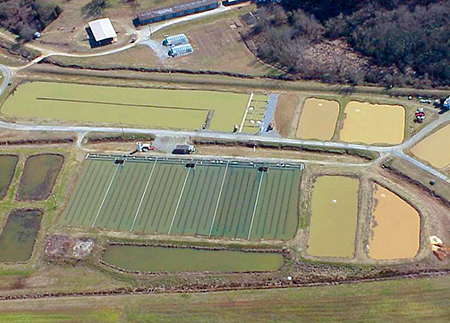
The water-quality characteristics of the partitioned aquaculture system (PAS) for intensive culture of catfish and co-culture of tilapia have been researched since 1989, when the system was designed at Clemson University in South Carolina, USA. PAS can achieve catfish yields up to four times higher than conventional earthen pond culture, while requiring only one-eighth as much water. Catfish production from a 0.8-ha PAS system reached 19.6 metric tons (MT) per hectare with coproduction of 6.1 MT per hectare last year.
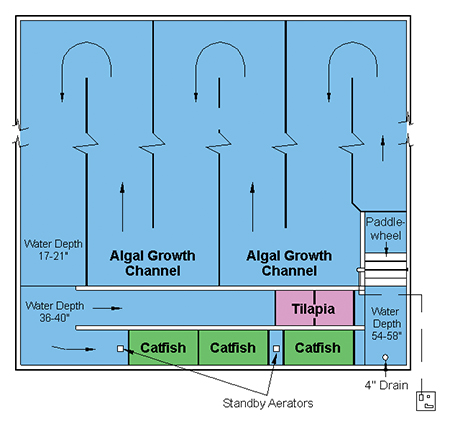
unit as operated at Clemson University in 1995.
Partitioned aquaculture combines high-density raceway culture of fish with paddlewheel-driven and high-rate algal growth oxidation channels (Fig. 1). Fish raceways allow excellent inventory and health management, and improve predator control, feeding, and harvesting efficiencies. The algae in the oxidation channels control organic and nitrogenous wastes and allow reuse of culture water to produce oxygen and detoxify waste nitrogen.
Algal-fish dynamics
In the PAS, inorganic nutrients (waste products) released by the cultured fish (catfish) are fixed by phytoplankton, cyanobacteria (blue-green algae), and green algae, which are then harvested by filter-feeder fish such as tilapia.
The harvesting of algae is an important component, as the algae remove potentially toxic ammonia and increase nutrient retention and conversion into fish flesh. Harvesting algae also helps to reduce the algal cell age in the water column, which in turn increases algal growth, the removal of waste, and production of oxygen.
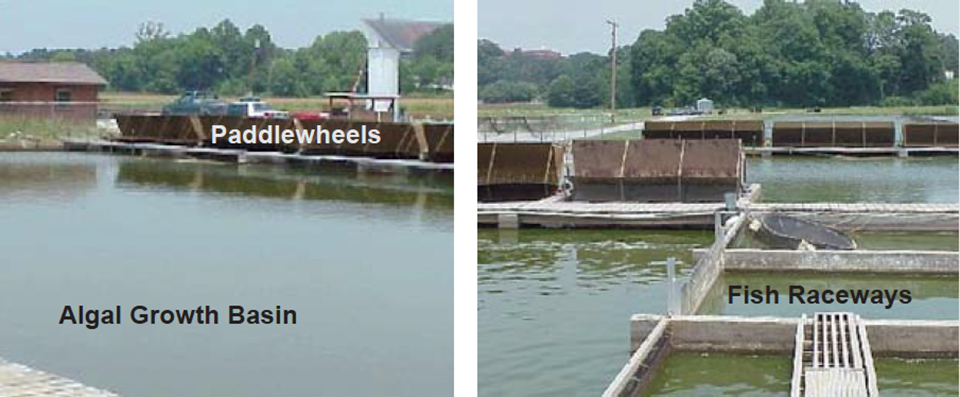
PAS water routinely contains several green algae and cyanobacteria taxa over the production season. The dominant green algae taxa are usually Scenedesmus and Ankistrodesmus, while Microcystis is the dominant cyano-bacterial taxa in the water column.
Filter-feeding experiments
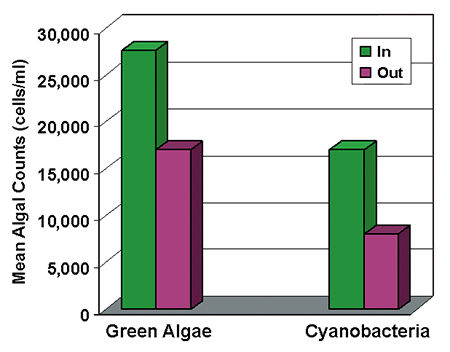
Four 0.01-ha experimental PAS units are dedicated to the quantification of the algal filter feeding kinetics of Nile tilapia (Oreochromis niloticus) and other filter feeders. The filter-feeding rate of Nile tilapia was estimated in timed, pulse-fed, filter-feeding chambers as mg particulate organic carbon (POC) of green algae and cyanobacteria.
Filtration rates were fit using Ivles’s 1961 model against POC concentration for green-algal and cyanobacterial water source. Algal taxa abundance in the incoming and filtered outgoing water was counted to estimate tilapia’s filter-feeding selectivity of green algae and cyanobacteria.
Observations
The filter feeding of Nile tilapia significantly reduced Scenedesmus and Microcystis in PAS water (Fig. 2). Filtration rates increased with POC concentration up to the maximum rate (Fig. 3).
The maximum filtration rate for cyanobacteria was significantly higher than green algae. The half-saturation coefficient for the tilapia filtration rate in green-algal water was lower than in cyanobacterial water. The lower half-saturation coefficient indicated a faster increase in filtration with increased POC concentration. The equivalent daily feeding rate (dry weight phytoplankton per wet weight fish) was 3.1 percent for green algae and 4.2 percent for cyanobacteria.
Conclusion
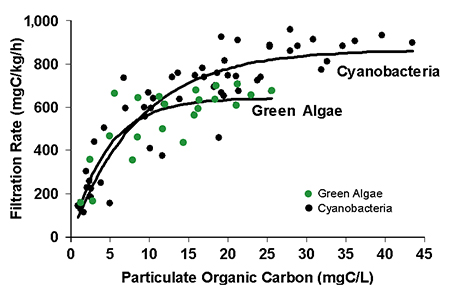
by Nile tilapia.
This research represents a first step in determining the biomass of Nile tilapia needed to control plankton growth in fertile partitioned aquaculture system water. The results also suggested that the use of Nile tilapia as a biological control of nuisance algae that can cause off-flavor in fish flesh (e.g., Microcystis) is a promising management tool for the PAS.
(Editor’s Note: This article was originally published in the February 2002 print edition of the Global Aquaculture Advocate.)
Now that you've finished reading the article ...
… we hope you’ll consider supporting our mission to document the evolution of the global aquaculture industry and share our vast network of contributors’ expansive knowledge every week.
By becoming a Global Seafood Alliance member, you’re ensuring that all of the pre-competitive work we do through member benefits, resources and events can continue. Individual membership costs just $50 a year. GSA individual and corporate members receive complimentary access to a series of GOAL virtual events beginning in April. Join now.
Not a GSA member? Join us.
Authors
-
Hakan Turker
Department of Aquaculture, Fisheries, and Wildlife
Clemson University
Clemson, South Carolina 29631 USA -
Arnold G. Eversole, Ph.D.
Department of Aquaculture, Fisheries, and Wildlife
Clemson University
Clemson, South Carolina 29631 USA -
David E. Brune, Ph.D.
Department of Agricultural and Biological Engineering
Clemson University
Related Posts

Responsibility
A look at integrated multi-trophic aquaculture
In integrated multi-trophic aquaculture, farmers combine the cultivation of fed species such as finfish or shrimp with extractive seaweeds, aquatic plants and shellfish and other invertebrates that recapture organic and inorganic particulate nutrients for their growth.

Responsibility
High-density split-pond systems offer high output, low maintenance
The split-pond culture system offers several advantages over traditional fish ponds. Aerating the small fish-confinement area is more effective at maintaining adequate levels of dissolved oxygen than in traditional ponds.

Responsibility
Integrated multi-trophic aquaculture, part 1
Integrated multi-trophic aquaculture involves cultivating fed species with extractive species that utilize inorganic and organic wastes for their growth.

Health & Welfare
The Shrimp Book: Intensive production of shrimp
With relatively low use of land and water, intensive aquaculture systems can support much higher production than extensive systems.


